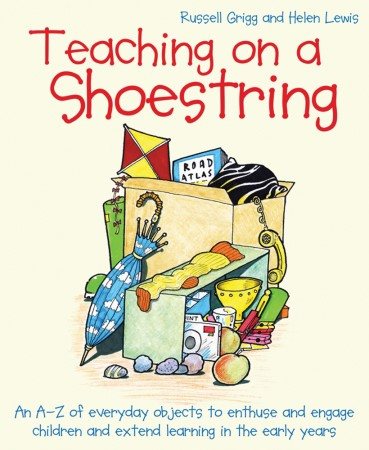- Home
- Publications
- Teaching on a Shoestring: An A–Z of everyday objects to enthuse and engage children and extend learning in the early years, by Russell Grigg and Helen Lewis, from Crown House Publishing
Teaching on a Shoestring: An A–Z of everyday objects to enthuse and engage children and extend learning in the early years, by Russell Grigg and Helen Lewis, from Crown House Publishing

ISBN 9781785833076
£16.99
Let’s consider the humble cardboard box
A recent survey of 2,000 parents of children aged three and above found that at Christmas time 46% of children prefer playing with boxes instead of actual toys.
The reality is that, despite the comercially driven world in which we live, children can still derive considerable pleasure and intellectual stimulation without expensive things. All they really need is a little good, old-fashioned imagination!
As adults we tend to miss the significance of simple things and take many everyday objects for granted. Despite what we may think, everyday objects matter. They provoke sentiment, offer emotional security and define who we are as individuals and as a society at large. The meaning we attach to objects changes depending on the context. When we look at objects – rosary beads, a tennis ball, a screwdriver, the latest iPhone – we make assumptions about the owner’s gender, age, interests, beliefs, dislikes and social and economic background. Objects raise big questions – for example, about prevailing political ideas and movements, social change and religious beliefs.
But more than that, at a time of ever-tightening school budgets these seemingly insignificant objects can be invaluable in affording low-cost, high-impact opportunities for learning – especially in the early years classroom.
One of the main reasons objects should be used in early years practice is that they have the potential to stimulate children’s natural curiosity and creative thinking. Babies and toddlers use their senses to explore the physical, observable aspects of their immediate surroundings. And as they acquire language, they begin to ask questions about the many objects they see, hear, feel, taste and smell in their environments, both natural and man-made.
This sense of wonder can be curtailed, however, through overly directive teaching, a prescribed assessment-led curriculum and an unstimulating learning environment. These factors can mitigate against children’s creativity, with lessons reduced to a guessing game in which children try to figure out what answers the teacher wants.
During their travels around pre-school settings and primary schools, Dr Russell Grigg and Dr Helen Lewis have seen some exceptional practitioners teaching on a shoestring budget. As a result they have written Teaching on a Shoestring: An A–Z of everyday objects to enthuse and engage children and extend learning in the early years to help others to do the same.
Russell and Helen argue that everyday objects are ideal to use as teaching aids because they are excellent resources to support children’s spiritual, moral, social and cultural development.
Skilled practitioners can bring a sense of awe into even the most familiar of objects. Take apples as an example. Some are the size of peas, others as large as small pumpkins; their colours range from yellow to lime green, chocolate brown and burgundy.
There is also a moral dimension to the use of objects. Museum curators regularly face dilemmas over what objects to collect and exhibit. The most frequently asked question at the British Museum is ‘Where are the mummies?’ But is it morally justifiable to display human remains as objects of morbid curiosity? Such questions can be posed to learners.
In these tight economic times, practitioners, educational managers and leaders are ever mindful of ‘value for money’ principles when building up collections of resources. Put simply, this means spending less, spending well and spending wisely. Russell and Helen show that there’s no need to spend anything – just look around you, what do you see?
Dr Russell Grigg has extensive experience in teacher training and has written many books and articles on the subject of primary education. He has recently taken up a post as school inspector and consultant for the Ministry of Education in the United Arab Emirates.
Dr Helen Lewis is a senior lecturer at the University of Wales Trinity Saint David, where she is responsible for developing close-to-practice research and enquiry. She is a former local authority mathematics adviser with expertise in developing young children’s thinking skills.
Please check the English Course for Teachers and School Staff at Pilgrims website.
Please check the Creative Methodology for the Classroom course at Pilgrims website.
Please check the Methodology and Language for Kindergarten course at Pilgrims website.
Please check the Methodology and Language for Primary course at Pilgrims website
Exam Literacy by Jake Hunton, from Crown House Publishing
Out of your seats by Anette Igel and James Thomas, from VERSATILE
Teaching on a Shoestring: An A–Z of everyday objects to enthuse and engage children and extend learning in the early years, by Russell Grigg and Helen Lewis, from Crown House Publishing
Tune into English October 2018
Fergal KavanaghELT Lesson Observation & Feedback Handbook by Jeanette Barsdell